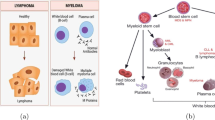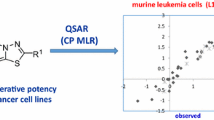Abstract
Topological indices are obtained from molecular graphs and are real numbers that can forecast the biological and physicochemical properties of several anti-cancer treatments, including skin cancer, breast cancer, and blood cancer. This article focuses on the application of topological indices in predicting the effectiveness of several drugs used to cure blood cancer, such as Pamidronic acid, Alpelisib, Prednisone, Olaparib, Ribociclib, Tucatinib, dexamethasone, docetaxel, Midostaurin, paclitaxel, toremifene, and venetoclax. The article investigates the mathematical relationships between physical and chemical qualities and data encoded in chemical structures under characteristics such as molecular weight, molar volume, and complexity. Several topological indices are used in this context to forecast the physicochemical characteristics of the drugs.


Similar content being viewed by others
Data availability
There is no data associative with this article.
Code availability
There is no code available for this article.
References
Arraut J et al. (2023) A second dose of dexamethasone reduces postoperative opioid consumption and pain in total joint arthroplasty. J Arthroplasty pp S0883–5403 (23) 00098.
Ashfield N et al (2023) Abstract P1-11-10: reversible versus irreversible tyrosine kinase inhibitors (TKIs) combined with antibody-drug conjugates (ADCs) in HER2-positive (HER2+) breast cancer (BC) cell lines. Cancer Res 83(5_Supplement):P1-11-10-P1-11-10
Aslam A et al (2017) On topological indices of certain dendrimer structures. Zeitschrift Für Naturforschung A 72(6):559–566
Balaban AT (1985) Applications of graph theory in chemistry. J Chem Inf Comput Sci 25(3):334–343
Chan C-H et al (2023) PAK and PI3K pathway activation confers resistance to KRASG12C inhibitor sotorasib. Br J Cancer 128(1):148–159
Dutreix C et al (2013) Investigation into CYP3A4-mediated drug–drug interactions on midostaurin in healthy volunteers. Cancer Chemother Pharmacol 72:1223–1234
Estrada E, Torres LA, Rodríguez L, Gutman I (1998) An atom-bond connectivity index: Modelling the enthalpy of formation of alkanes. Indian J Chem 37A:849–855
Favaron O, Mahéo M, Saclé J-F (1993) Some eigenvalue properties in graphs (conjectures of Graffiti—II). Discret Math 111(1–3):197–220
Figuerola B, Avila C (2019) The phylum bryozoa as a promising source of anticancer drugs. Mar Drugs 17(8):477
Furtula B, Gutman I (2015) A forgotten topological index. J Math Chem 53(4):1184–1190
Gupta A et al (2023) Cyclin-dependent kinases in cancer: role, regulation, and therapeutic targeting. Adv Protein Chem Struct Biol 135:21–55
Gutman I, Trinajstić N (1972) Graph theory and molecular orbitals. Total φ-electron energy of alternant hydrocarbons. Chem Phys Lett 17(4):535–538
Hansen PJ, Jurs PC (1988) Chemical applications of graph theory. Part I. Fundamentals and topological indices. J Chem Educ 65(7):574
Havare ÖÇ (2021) The inverse sum indeg index (ISI) and ISI energy of Hyaluronic Acid-Paclitaxel molecules used in anticancer drugs. Open J Discrete Appl Math 4(3):72–81
Herasymiuk I, Herman O, Ilkiv O (2023) Ultrastructural features of the rearrangement of the cells of the hematotesticular barrier and the spermatogenic epithelium of the rats testicles during the sudden withdrawal of prednisolone after its long-term introduction in high doses. Georgian Med News 334:137–141
Hosamani S et al (2017) QSPR analysis of certain degree based topological indices. J Stat Appl Probab 6(2):361–371
Imran M et al (2019) Topological properties of cellular neural networks. J Intell Fuzzy Syst 37(3):3605–3614
Jenkinson CP, Grody WW, Cederbaum SD (1996) Comparative properties of arginases. Comp Biochem Physiol B Biochem Mol Biol 114(1):107–132
Khabyah AA et al (2022) Minimum zagreb eccentricity indices of two-mode network with applications in boiling point and benzenoid hydrocarbons. Mathematics 10(9):1393
Khalifeh M, Yousefi-Azari H, Ashrafi AR (2009) The first and second Zagreb indices of some graph operations. Discrete Appl Math 157(4):804–811
Kosar Z, Zaman S, Siddiqui MK (2023) Structural characterization and spectral properties of hexagonal phenylene chain network. Eur Phys J Plus 138(5):415
Kristjanson LJ, Ashcroft T (1994) The family’s cancer journey: a literature review. Cancer Nurs 17(1):1–17
Le T et al (2012) Quantitative structure–property relationship modeling of diverse materials properties. Chem Rev 112(5):2889–2919
Li Q et al (2020) Study on the normalized Laplacian of a penta-graphene with applications. Int J Quantum Chem 120(9):e26154
Li Y et al (2023) A real-world study of the effects of endocrine therapy on liver function in breast cancer. Zhonghua Wai Ke Za Zhi [Chinese J Surg] 61(2):107–113
Liu J-B et al (2019a) The Hosoya index of graphs formed by a fractal graph. Fractals 27(08):1950135
Liu J-B et al (2019b) Zagreb indices and multiplicative Zagreb indices of Eulerian graphs. Bull Malays Math Sci Soc 42:67–78
Liu J-B, Bao Y, Zheng W-T (2022) Analyses of some structural properties on a class of hierarchical scale-free networks. Fractals 30(07):2250136
Liu JB, Gu JJ, Wang K (2023a) The expected values for the Gutman index, Schultz index, and some Sombor indices of a random cyclooctane chain. Int J Quantum Chem 123(3):e27022
Liu Y, Zhao F, Wang Q, Zhao Q, Hou G, Meng Q (2023b) Current Perspectives on Paclitaxel: Focus on Its Production, Delivery and Combination Therapy. Mini Rev Med Chem 23(18):1780–1796
Malik MYH et al (2021) Predictive potential of spectrum‐based topological descriptors for measuring the π‐electronic energy of benzenoid hydrocarbons with applications to boron triangular and boron α‐nanotubes. Math Methods Appl Sci. https://doi.org/10.1002/mma.7161
Naeem M, Rauf A (2023) Degree based weighted entropy indices of hyaluronic acid–curcumin conjugates: an anti-tumor drug. Polycycl Aromat Compd 43(1):482–499
Naeem M et al (2022) Degree-based topological indices of geranyl and farnesyl penicillin G bioconjugate structure. Eur Phys J Plus 137(3):303
Naeem M et al (2023a) Computation of degree-based topological indices for porphyrazine and tetrakis porphyrazine. Mol Phys 121:e2205534
Naeem M et al (2023b) QSPR modeling with curvilinear regression on the reverse entropy indices for the prediction of physicochemical properties of benzene derivatives. Polycycl Aromat Compd 2023:1–18
Nasir S, Farooq FB, Parveen S (2022) Topological indices of novel drugs used in blood cancer treatment and its QSPR modeling. AIMS Math 7(7):11829–11850
Ouni L, Ramazani A (2023) In silico screening of some anti-cancer drugs against the main protease of COVID-19 using molecular docking. Lett Org Chem 20(1):77–90
Prabhu S et al (2021) Molecular topological characterization of three classes of polycyclic aromatic hydrocarbons. J Mol Struct 1229:129501
Randic M (1975) Characterization of molecular branching. J Am Chem Soc 97(23):6609–6615
Shanmukha M, Basavarajappa N, Anilkumar K (2020) Predicting physicochemical properties of octane isomers using QSPR approach. Malaya J Mathematik 8(1):104–116
Shanmukha M et al (2022) Degree-based molecular descriptors and QSPR analysis of breast cancer drugs. J Math 2022:1–13
Shirdel G, Rezapour H, Sayadi A (2013) The Hyper-Zagreb Index of Graph Operations. Iran J Math Chem 4(2):213–220
Suzuki M et al (2023) Genome destabilization-associated phenotypes arising as a consequence of therapeutic treatment are suppressed by Olaparib. PLoS ONE 18(1):e0281168
Wang G et al (2020) The connective eccentricity index of graphs and its applications to octane isomers and benzenoid hydrocarbons. Int J Quantum Chem 120(18):e26334
Wang Y et al (2023) Clinical observation of venetoclax combined with demethylating agents on the treatment of relapsed/refractory acute myeloid leukemia. Zhongguo Shi Yan Xue Ye Xue Za Zhi 31(2):327–332
Wang L et al. (2023b) The safety of neoadjuvant therapy with polyethylene glycol liposome Adriamycin combined with docetaxel in patients with breast cancer complicated by axillary lymph node metastasis. Altern Ther Health Med pp AT7976–AT7976
Yan T et al (2023) Spectral techniques and mathematical aspects of K 4 chain graph. Phys Scr 98(4):045222
Yu X et al (2023) Matrix analysis of hexagonal model and its applications in global mean-first-passage time of random walks. IEEE Access 11:10045–10052
Zaman S (2021) Cacti with maximal general sum-connectivity index. J Appl Math Comput 65:147–160
Zaman S (2022) Spectral analysis of three invariants associated to random walks on rounded networks with 2 n-pentagons. Int J Comput Math 99(3):465–485
Zaman S, Ali A (2021) On connected graphs having the maximum connective eccentricity index. J Appl Math Comput 67(1–2):131
Zaman S, He X (2022) Relation between the inertia indices of a complex unit gain graph and those of its underlying graph. Linear Multilinear Algebra 70(5):843–877
Zaman S, Ullah A (2023) Kemeny’s constant and global mean first passage time of random walks on octagonal cell network. Math Methods Appl Sci 46(8):9177–9186
Zaman S et al (2021) Maximum H-index of bipartite network with some given parameters. AIMS Math 6(5):5165–5175
Zaman S et al (2022) The Kemeny’s constant and spanning trees of hexagonal ring network. Comput Mater Continua 73(3):6347
Zaman S et al (2023) Study of mean-first-passage time and Kemeny’s constant of a random walk by normalized Laplacian matrices of a penta-chain network. Eur Phys J Plus 138(8):770
Zhou B, Trinajstić N (2010) On general sum-connectivity index. J Math Chem 47:210–218
Funding
This study did not receive any funding in any form.
Author information
Authors and Affiliations
Contributions
All authors have equally contributed to this manuscript in all stages, from conceptualization to the write up of final draft.
Corresponding author
Ethics declarations
Conflict of interest
The authors declare no any conflict of interest/competing interests.
Additional information
Publisher's Note
Springer Nature remains neutral with regard to jurisdictional claims in published maps and institutional affiliations.
Rights and permissions
Springer Nature or its licensor (e.g. a society or other partner) holds exclusive rights to this article under a publishing agreement with the author(s) or other rightsholder(s); author self-archiving of the accepted manuscript version of this article is solely governed by the terms of such publishing agreement and applicable law.
About this article
Cite this article
Zhang, X., Bajwa, Z.S., Zaman, S. et al. The study of curve fitting models to analyze some degree-based topological indices of certain anti-cancer treatment. Chem. Pap. 78, 1055–1068 (2024). https://doi.org/10.1007/s11696-023-03143-1
Received:
Accepted:
Published:
Issue Date:
DOI: https://doi.org/10.1007/s11696-023-03143-1




